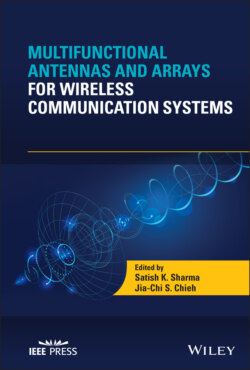Читать книгу Multifunctional Antennas and Arrays for Wireless Communication Systems - Группа авторов - Страница 11
Preface
ОглавлениеMultifunctional antennas and arrays are the new trend in the field of antennas for diversified applications such as wireless and satellite communications as well as for radar applications. Reconfigurable antennas starting from frequency reconfiguration, pattern reconfiguration to polarization reconfiguration and their combinations make these antennas not only multifunctional but also reduce space requirements on the host communication devices. In the last two decades there has been great efforts to design and realize these reconfigurable antennas and we anticipate even more efforts to come in the near future. A wide range of sub‐topics as they apply to multifunction antennas and arrays include the design and development of the reconfigurable multiple‐input‐multiple‐output (MIMO) antennas, liquid metal antennas, piezoelectric antennas, radio frequency (RF) micro‐electro‐mechanical‐systems (MEMS) based reconfigurable antennas, multifunctional antennas for 4G/5G communications and MIMO applications, metamaterials reconfigurable antennas, multifunctional antennas for user equipment (EUs), reconfigurable antennas for the defense applications and phased array antennas using 5G silicon RFICs.
The purpose of this book is to present in‐depth theory, as well as design and development insight of these various multifunctional antennas and arrays. The book is aimed for use by practicing antenna engineers and researchers in the industry and academia. This book starts with an introduction to the antennas in Chapter 1, which discusses the importance of antennas. It also provides an introduction to antenna performance parameters, antenna types, multifunctional antennas, reconfigurable antennas, and antenna measurements. Next in Chapter 2, frequency reconfigurable antennas (FRAs) are detailed. This chapter starts with discussion of the mechanism of frequency reconfigurability, types of the FRAs using various switches and tunable components, FRAs by employing mechanical changes such as ground plane membrane deflection, and FRAs by using special materials and special shapes. Chapter 3 presents discussion on the pattern reconfigurable antennas which includes the following: pattern reconfiguration by electronically changing antenna elements and feeding networks, mechanically controlled pattern reconfigurable antennas, pattern reconfigurable arrays and optimizations, and reconfigurable wearable and implanted antennas. In Chapter 4, we discuss the polarization reconfigurable antennas with emphasis on the polarization reconfiguration mechanism using RF switches, polarization reconfigurable antennas using solid‐state RF switches, mechanical and micro‐electro‐mechanical‐system (MEMS) RF switches, switchable feed networks, usage of metasurfaces, as well as other methods. These chapters describe the three main types of reconfigurable antennas and arrays as described in the introduction.
Reconfigurable antennas using the liquid metal, piezoelectric and RF MEMS are discussed in Chapter 5. This chapter specifically includes discussion on the liquid metal based frequency, pattern, and directivity reconfigurable antennas, piezoelectric based pattern reconfigurable arrays, and RF MEMS based frequency and pattern reconfigurable antennas. Compact reconfigurable antennas are discussed in Chapter 6 with the main focus on the reconfigurable pixel antennas, and reconfigurable antennas using fluidic, ferrite and magnetic materials, metamaterials and metasurfaces.
Reconfigurable MIMO antennas are presented in Chapter 7, which discusses the following: reconfigurable antennas for MIMO applications, isolation techniques in MIMO antennas, pattern diversity scheme, reconfigurable polarization MIMO antennas, MIMO antenna performance parameters, and finally some reconfigurable MIMO antenna examples. Chapter 8 offers discussion on the MIMO antennas in multifunctional systems, MIMO antennas in Radar systems, MIMO antennas in communication systems, MIMO antennas for sensing applications, MIMO antennas for 5G systems, massive MIMO arrays, dielectric lens for millimeter wave MIMO, beamforming in massive MIMO, MIMO in imaging systems, and MIMO antenna in medical applications. Use of metamaterials in reconfigurable antennas have been addressed in Chapter 9. This chapter focuses the discussion on metamaterials in antenna reconfigurability, metamaterial‐inspired reconfigurable antennas, and metasurface‐inspired reconfigurable antennas.
Chapter 10 provides detailed discussion on the multifunctional antennas for user equipments (UEs) with emphasis on the lower/sub‐6 GHz 5G band antennas, 5G mm‐wave antenna arrays, collocated sub‐6 GHz and mm‐Wave 5G array antennas, and RF and electromagnetic fields (EMF) exposure limits. The department of defense (DoD) related reconfigurable antennas are presented in Chapter 11 with a focus on the tactical air navigation system (TACAN) antennas, sea‐based X‐Band Radar 1 (SBX‐1) antennas, the advanced multifunction RF concept (AMRFC) antennas, integrated topside (InTop) antennas, the Defense Advanced Research Projects Agency (DARPA) arrays of commercial timescales (ACT), and the Air Force Research Laboratory (AFRL) transformational element level array (TELA). Finally, Chapter 12 discusses 5G silicon RFICs‐based phased array antennas, which introduces silicon beamformer technology. It includes a short discussion of three phase shifting topologies using local oscillator (LO) based phase shifting, intermediate frequency (IF) based phase shifting and RF based phase shifting for beam steering array antennas. Several flat panel phased array antenna examples using the silicon beamforming chipsets both at Ku‐ and Ka‐band with linear and circular polarizations are also presented.
We would like to mention that the slight overlap between the content in couple of chapters is acknowledged. We have done this intentionally so that discussion is complete in the respective chapters. While the contributors and authors have made great effort to present details for each topic area, they are by no means complete as the body of work in this field is large. They do represent the interpretations of each chapter’s contributors. As time progresses, further improvements and innovations in the state‐of‐the‐art technologies in reconfigurable antennas is anticipated. Therefore, it is expected that interested readers should continually refresh their knowledge to follow the growth of communication technologies.
Professor Satish K. Sharma, PhDJia‐Chi S. Chieh, PhD
1 February 2021
San Diego, CA, USA
